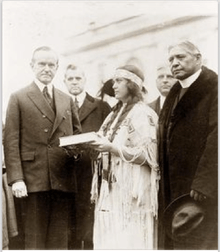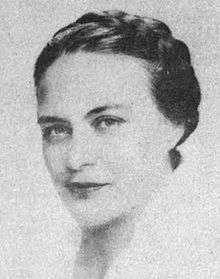Ruth Muskrat Bronson
| Ruth Muskrat Bronson | |
|---|---|
 1923 | |
| Born |
Ruth Margaret Muskrat October 3, 1897 White Water, Delaware Nation Reservation, Indian Territory |
| Died |
June 12, 1982 (aged 84) Tucson, Arizona |
| Nationality | American |
| Occupation | poet, educator, Indian rights activist |
| Years active | 1925-1982 |
| Known for | first Guidance and Placement Officer of the Bureau of Indian Affairs |
Ruth Muskrat Bronson (October 3, 1897 – June 12, 1982) was a Cherokee poet, educator and Indian rights activist. After completing her education, Bronson became the first Guidance and Placement Officer of the Bureau of Indian Affairs. She then served as executive secretary for the National Congress of American Indians and created their legislative news service. After a decade of work in Washington, D.C., Bronson moved to Arizona and served as a health education specialist for the Indian Health Service and was honored upon her retirement from government service by the Oveta Culp Hobby Service Award from the Department of Health, Education and Welfare. She continued working for Native American rights for involvement in their own development and leadership in the private sector until her death.
Early life

Ruth Margaret Muskrat was born on October 3, 1897[1] in White Water,[2] on the Delaware Nation Reservation in Indian Territory to Ida Lenora (née Kelly), of Irish-English stock and a transplant from Missouri, and James Ezekial Muskrat, a Cherokee, whose forebearers had made the Trail of Tears from Georgia to Indian Territory in the 19th century.[1] When she was ten years old, she witnessed the disruption caused to the lives of her nation when the Curtis Act of 1898, an amendment of the Dawes Act, extended allotment over the Five Civilized Tribes.[3] At the age of fourteen, she enrolled in preparatory school[4] at the Oklahoma Institute of Technology in Tonkawa, graduating in 1916. She went on to further her education at Henry Kendall College in Tulsa and at Northeastern State Teachers College.[3] Financial hardship then forced her to stop her education briefly and teach for two years to earn sufficient funds to continue her schooling.[5]
In 1919, Muskrat enrolled at the University of Oklahoma,[4] where she spent three semesters.[3] During the summer of 1921, she was sent to work on the Mescalero Apache Reservation in New Mexico by the YWCA. Her report on her organizing efforts there, earned her a scholarship to attend the University of Kansas,[5] where she spent three more semesters of study.[3] In 1922, Muskrat went to Peking, China as part of a YWCA delegation for the youth conference. She was one of the first Native American girls to serve as a student delegate abroad.[6] The trip, which also included stops in "Hawaii, Manchuria, Japan, Korea and Hong Kong" brought Muskrat to the attention of the international press and awoke in her a desire for racial equality.[5] The following year, she delivered an appeal to the United States government for better educational facilities for Native Americans.[7] The presentation was part of a gathering of Native American leaders, known as the "Committee of One Hundred" to advise the president on American Indian policy. Muskrat advocated for Indians to be involved in solving their own problems.[3] Moved by her speech, President Calvin Coolidge and his wife, Grace, invited Muskrat to lunch with them.[7] In 1923, she enrolled in Mount Holyoke College and in 1925 graduated with a BA[3] in English. During her college days, Muskrat was a prolific poet influenced by the Modernist movement.[5]
Career
As soon as she graduated, Muskrat began working at the Haskell Institute first as a teacher,[3] and then as the head of the college placement bureau. She won the Henry Morgenthau Prize in 1926 for best use of her college education in the first year after completing her education.[8][2] In 1928, Muskrat married John F. Bronson and they adopted a native girl.[9] In 1931, the Bureau of Indian Affairs (BIA) created a new program to improve educational opportunities for Native Americans. Bronson was appointed as the first Guidance and Placement Officer of the bureau and tasked with helping graduates find viable employment.[10][11] In 1937, she was awarded the Indian Achievement Medal of the Indian Council Fire, as the second woman to have received the award since its inception.[12] She had previously been nominated for the award in its inaugural year in 1933.[13] Bronson was in charge of distributing government loans and scholarships for students as well as helping them find job placements. She remained in the post for the BIA until 1943.[2]

Bronson spent a few years raising her daughter,[2] though she did publish several books and articles including Indians are People Too (1944),[14] The Church in Indian Life(1945)[15] and Shall We Repeat Indian History in Alaska? (1947) in this period.[16] In 1945, Bronson began working with the National Congress of American Indians (NCAI) and soon emerged as a leader. She was appointed as the executive secretary of the organization and spent a decade monitoring legislative issues. She established the NCAI's legislative news service[3] and spoke at various tribal meetings throughout the country, promoting Native American progress.[17] Some of the issues Bronson was involved with at the NCAI were the debates over native water rights along the Colorado River,[18] native rights in the Territory of Alaska,[19] and medical care for American Indians. After ten years of serving as executive secretary, in 1955, Bronson was elected as treasurer of the NCAI in 1955,[20] but she was tired of the contentiousness of national politics and began focusing more on ways to work with local communities.[3]
In 1957, Bronson moved to Arizona and became a health education specialist at the San Carlos Apache Indian Reservation for the Indian Health Service.[3] During the same period, she served as a vice president of the philanthropic ARROW Organization. She managed the education loan and scholarship fund of the organization, as well as advising tribes on community development. In 1962, Bronson was awarded the Oveta Culp Hobby Service Award from the Department of Health, Education and Welfare for her work serving Native Americans[21] and retired from government service, moving to Tucson.[22] In 1963, Bronson became the national program chairman of the Community Development Foundation’s American Indian section. The organization operated under the umbrella of the Save the Children Federation.[23] After a stroke in 1972, Bronson slowed, but did not stop her activism for Native Americans to be allowed to determine their own development and leadership programs.[24] In 1978, Bronson was one of the recipients of the National Indian Child Conference's merit award for commitment to improving children's quality of life.[25]
Bronson died on June 12, 1982 in Tucson, Arizona.[26]
References
Citations
- 1 2 Harvey 2004, p. 80.
- 1 2 3 4 Gridley 1947, p. 14.
- 1 2 3 4 5 6 7 8 9 10 Harvey 2004, p. 81.
- 1 2 Harvey 2003, p. 55.
- 1 2 3 4 Parker 2011, p. 320.
- ↑ The Winston-Salem Journal 1922, p. 5.
- 1 2 The Brook Reporter 1923, p. 6.
- ↑ The Chicago Heights Star 1926, p. 8.
- ↑ Mount Holyoke College 2016.
- ↑ The Iola Register 1931, p. 1.
- ↑ The Escanaba Daily Press 1931, p. 6.
- ↑ The Miami Daily News-Record 1937, p. 7.
- ↑ The Current Local 1933, p. 6.
- ↑ Bronson 1944.
- ↑ Bronson 1945.
- ↑ Cowger 2001, p. 175.
- ↑ The Independent Record 1948, p. 16.
- ↑ The Reno Evening Gazette 1953, p. 14.
- ↑ de Armond 1954, p. 7.
- ↑ The News-Review 1955, p. 11.
- ↑ The Tucson Daily Citizen 1962, p. 18.
- ↑ Parker 2011, p. 321.
- ↑ Kuehlthau 1963, p. 62.
- ↑ Harvey 2004, p. 82.
- ↑ The Alamogordo Daily News 1978, p. 9.
- ↑ The New York Times 1982.
Bibliography
| Wikimedia Commons has media related to Ruth Muskrat. |
- Bronson, Ruth Muskrat (1945). The Church in Indian Life. New York, New York: Home Missions Council of North America. OCLC 57142222.
- Bronson, Ruth Muskrat (1944). Indians are People Too. New York, New York: Friendship Press. OCLC 609271119.
- Cowger, Thomas W. (2001). The National Congress of American Indians: The Founding Years. Lincoln, Nebraska: University of Nebraska Press. ISBN 0-8032-6414-3.
- de Armond, Bob (November 1, 1954). "A Northern Notebook". Fairbanks, Alaska: The Fairbanks Daily News-Miner. Retrieved 4 August 2016 – via Newspapers.com.

- Gridley, Marion Eleanor (1947). Indians of today. Sponsored by the Indian Council Fire (2nd ed.). Chicago, Illinois: Millar Publishing Company. OCLC 616116891.
- Harvey, Gretchen G. (2003). "Bronson, Ruth Muskrat". In Bataille, Gretchen M.; Lisa, Laurie. Native American Women: A Biographical Dictionary (2nd ed.). New York, New York: Routledge. pp. 55–56. ISBN 978-1-135-95587-8.
- Harvey, Gretchen G. (2004). "Bronson, Ruth Muskrat". In Ware, Susan; Braukman, Stacy. Notable American Women: A Biographical Dictionary Completing the Twentieth Century. 5. Cambridge, Massachusetts: Harvard University Press. pp. 80–82. ISBN 978-0-674-01488-6.
- Kuehlthau, Marge (November 22, 1963). "Cherokee Gets Irish Up and Fights for Indians". Tucson, Arizona: The Tucson Daily Citizen. Retrieved 4 August 2016 – via Newspapers.com.

- Parker, Robert Dale, ed. (2011). Changing Is Not Vanishing: A Collection of American Indian Poetry to 1930. Philadelphia, Pennsylvania: University of Pennsylvania Press. ISBN 0-8122-0006-3.
- "Achievement Medal to Ruth Muskrat". Miami, Oklahoma: The Miami Daily News-Record. September 21, 1937. Retrieved 4 August 2016 – via Newspapers.com.

- "Chino one of Indian leaders receiving NICC merit Awards". Alamogordo, New Mexico: The Alamogordo Daily News. December 1, 1978. Retrieved 4 August 2016 – via Newspaperarchive.com.

- "Indians Conclude 21st Convention Make Requests". Roseburg, Oregon: The News-Review. September 6, 1955. Retrieved 4 August 2016 – via Newspapers.com.

- "Indians Press River Water Claim". Reno, Nevada: The Reno Evening Gazette. December 11, 1953. Retrieved 4 August 2016 – via Newspaperarchive.com.

- "Miss Muskrat in Gov't Service". Iola, Kansas: The Iola Register. January 9, 1931. Retrieved 4 August 2016 – via Newspapers.com.

- "Miss Ruth Muskrat, Indian Girl, Dines at White House". Brook, Indiana: The Brook Reporter. December 21, 1923. Retrieved 4 August 2016 – via Newspapers.com.

- "Montana Indian Tribes Will Honor Ruth Muskrat Bronson at Annual Meeting of T.B. Association". Helena, Montana: The Independent Record. August 26, 1948. Retrieved 4 August 2016 – via Newspapers.com.

- "Ruth Muskrat". Chicago Heights, Illinois: The Chicago Heights Star. July 27, 1926. Retrieved 4 August 2016 – via Newspapers.com.

- "Ruth Muskrat Bronson". South Hadley, Massachusetts: Mount Holyoke College. 2016. Archived from the original on August 4, 2016. Retrieved 4 August 2016.
- "Ruth Muskrat, Indian Girl, Going to China". Winston-Salem, North Carolina: The Winston-Salem Journal. AP. March 31, 1922. Retrieved 4 August 2016 – via Newspapers.com.

- "Ruth Muskrat Is Appointed Guide of Indian Girls". Escanaba, Michigan: The Escanaba Daily Press. AP. January 27, 1931. Retrieved 4 August 2016 – via Newspapers.com.

- "Ruth Muskrat Bronson, 84; A Specialist in Indian Affairs". New York City, New York: The New York Times. June 24, 1982. Retrieved 3 August 2016.
- "Tucsonian Honored For Indian Work". Tucson, Arizona: The Tucson Daily Citizen. April 13, 1962. Retrieved 4 August 2016 – via Newspapers.com.

- "Who is the Greatest Indian of Today?". Van Buren, Missouri: The Current Local. AP. August 31, 1933. Retrieved 4 August 2016 – via Newspapers.com.
